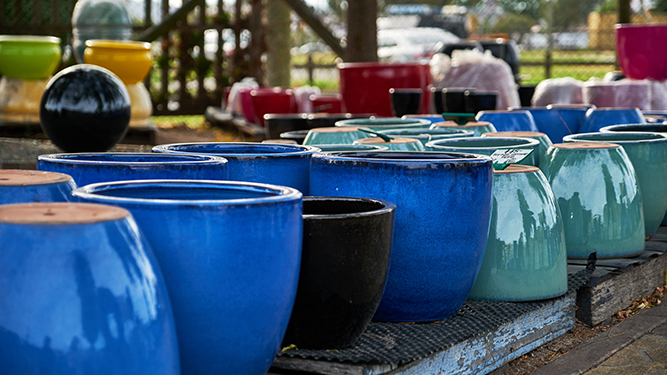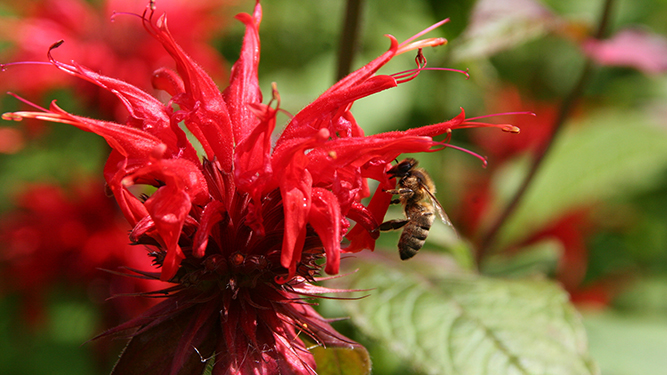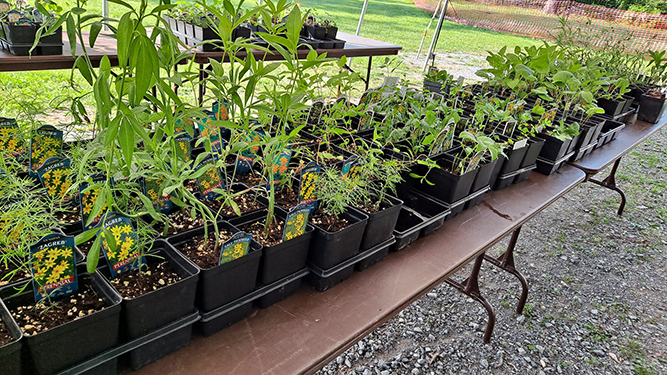During a conference recently, author Doug Tallamy was making a case for
Homegrown National Park -- a call to homeowners to make their yards and gardens “support life, sequester carbon, feed pollinators and manage water.”
And then, someone asked what they should do as a renter in an apartment.
Tallamy answered that if all of the renters with balconies or doorsteps in cities and towns grew native plants in containers, pollinators would not discriminate between them and natives planted in the ground in a yard.
With garden season upon us, here are tips and techniques from Department of Conservation and Natural Resources staff for planting native plants in containers for pollinators.
Get Started with an Urban Pollinator Garden

Even if your residence provides only a small space, you can help pollinators!
To get started, pick the spot on your balcony or doorstep that gets the most sun, as many pollinator plants like sunlight.
There are limited options for flower power in the shade, so taking advantage of leaf colors and textures can be helpful to provide interest.
Think vertically as well as horizontally. You can train vines around your railings or up a trellis, and use wall planters or a shelf for smaller plants.
Window boxes along railings or windows can also accommodate pollinator plants.
For ideas, check the
U.S. Fish and Wildlife Service balcony pollinator design plan.
For planters and soil, consider:
Glazed pots or resin pots will retain moisture better; clay pots could be impacted by freezing temperatures.
Larger pots mean more room for healthy roots, so opt for pots as large as will reasonably fit in your space.
Deep containers are your friend. Choose containers at least 16 inches deep to allow your native plants to build strong root systems and thrive for years to come.
Choose colors that will complement your plants of choice -- contrast is attractive to pollinators.
Make sure the planter has drainage holes.
Native Plant Selections for Pots

Beebalm (Monarda didyma)
Different species of plants bloom at different points in the growing season. Choose plants with a variety of bloom times to provide pollinators nectar as the seasons change.
For your first container, try picking three plants: one that blooms in early summer, one in mid-summer, and one in fall.
Plants that are more cold-hardy will do better, and drought tolerant species will reduce watering needs.
Make sure to choose plants with a height and width that will fit into your garden space! Accommodate for the space that planters will take by adding an extra three inches per plant.
“Native perennials can grow tall and if people are expecting smaller plants, they may be surprised,” said Department of Conservation and Natural Resources’ Bureau of Forestry Botanist Chris Firestone. “I would suggest common blue violet as a species that is smaller and not as tall. Pussytoes, creeping phlox, and some short sedges, like Pennsylvania sedge, also would be shorter species.”
On shady balconies, using plants that are shade tolerant is important.
“Heucheras have done well in my experience in containers and survived well,” said Urban and Community Forestry Tree Specialist Orsi Lazar. “Lady and Christmas ferns, and various sedges work well with heucheras or foam flower for planters in shade.”
Some ideas for native perennials that are container-friendly and loved by butterflies and bees are:
Beebalm (Monarda didyma), wild bergamot: is showy, attractive to pollinators, and a native perennial
Butterfly weed (Asclepias tuberosa), milkweed: Penn State Extension says monarchs and milkweed are closely tied
Creeping phlox (Phlox stolonifera): Phlox in the Home Garden says the plant is completely covered in pastel-colored flowers in spring
Little bluestem (Schizachyrium scoparium): A perennial grass to add texture and movement, as well as being a major resource for local pollinators. Learn more in a little bluestem summary from the Mount Cuba Center.
Wood geranium (Geranium maculatum): Pennsylvania Enflowered describes the flowers of wood geranium appearing like the beak of a bird, leading to the common name of crane’s bill.
Golden ragwort (Packera aurea): The Alliance for the Chesapeake Bay says golden ragwort is native in the watershed and has yellow flowers.
Wild ginger (Asarum canadense): The U.S. Forest Service says wild ginger is an early spring wildflower and was used by Native Americans as a spice.
Beardtongue (Penstemon digitalis): Penn State Extension says beardtongue also can be used in rain gardens.
Oxeye sunflower (Heliopsis helianthoides): Pennsylvania Enflowered lists oxeye sunflower as a tall plant.
Orange coneflower (Rudbeckia fulgida): This native can bloom from July until October.
Mountain mints (Pycnanthemum spp.): The mountain mints are some of the absolute best plants for attracting and supporting pollinators.
New England aster (Symphyotrichum novae-angliae): The Carnegie Museum of Natural Science says New England aster will provide fall blooms.
Aromatic aster (Symphyotrichum oblongifolium): Aromatic aster could be used instead of non-native mums for fall bloom.
Partridge pea (Chamaecrista fasciculata): Wild Flowers of Pittsburgh describes partridge pea with cheery yellow flowers. Note this plant is an annual.
Once you have planted, don’t forget to water the soil often (rather than watering the leaves).
Soil in containers dries out faster, and as your plants become root bound, they will need water more frequently.
Native plants are adapted to soils that are low in nutrients. Low nutrient level means plants will be shorter and sturdier.
Missouri Botanical Gardens has a web page on container gardening with native plants, although not all of the species are native to Pennsylvania.
How to Care for Native Container Gardens in Winter
The soil in containers tends to get a little colder than the soil in the ground.
“If there are heavy freezes in winter, some plants may not come back the following year unless soils are kept damp and above freezing in a garage or another sheltered environment, which isn’t different from most annual offerings, really,” said Department of Conservation and Natural Resources’ Bureau of Forestry Natural Resource Program Specialist Ryan Reed. “Saving seed from year to year is a good option. I saved seed from bee balm, oxeye sunflower, milkweed, and partridge pea, which germinated readily the following year.”
Protect your container plants over the winter with 3 to 4 inches of leaf mulch or by moving your planter to a less exposed area.
The key is to keep the soil warm enough, so the roots don’t freeze through.
Where to Find Native Plants for Containers

You should not dig wild plants from public lands or other’s properties. Select plants that can be grown from seed or purchased from reputable nurseries.
Find information about where to buy native plants on the DCNR website.
Enjoy the beauty of the potted plants on your balcony or doorstep and feel good about helping pollinators!